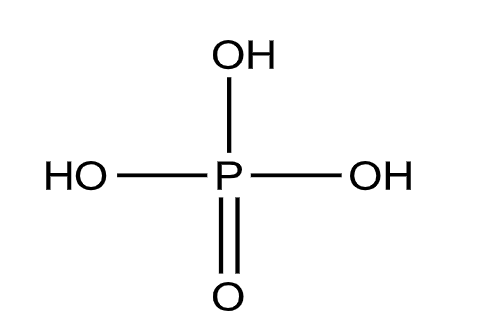
The basicity of phosphoric acid is:-
(a)- 1
(b)- 2
(c)- 3
(d)- 4
Answer
124.5k+ views
Hint: For checking the basicity of a compound the structure is drawn. The type of bonds the central metal atom forms and the group joined to the metal atom is to be found out. Electronegativity of the atom is also checked.
Complete step by step answer:
When oxoacids of phosphorus are formed, it shows basic character.
This basic character is because of the presence of an OH group present in the compound.
The OH group present is ionizable because the H atom is attached to a highly electronegative atom O (oxygen). When dissolved in water the hydrogen ions get separated which tells the basicity of the compound.
So, to check the basicity of the compound we have to count the number of OH group present which are directly attached to the central atom
Phosphoric acid has a formula \[{{H}_{3}}P{{O}_{4}}\].
In this, the phosphorus has a +5 oxidation state.
Let us now see the structure of the phosphoric acid \[{{H}_{3}}P{{O}_{4}}\].

From the structure, we can see that there are three P-OH bonds and one P=O bond.
So, due to the presence of three P-OH bonds, it can give 3 hydrogen ions when dissolved in water.
Hence the correct option is (c)- 3.
Additional information:
The basicity of some oxoacids of phosphorus are:
The phosphinic acid (\[{{H}_{3}}P{{O}_{2}}\]) has basicity 1
The hypophosphoric acid (\[{{H}_{4}}{{P}_{2}}{{O}_{6}}\]) has basicity 4.
The peroxodiphosphoric acid (\[{{H}_{4}}{{P}_{2}}{{O}_{8}}\]) has basicity 4.
Note:
The chemical properties of the members of a homologous series similar though the first member may vary considerably from the rest of the members. The successive members of a homologous series differ by a \[C{{H}_{2}}\] group or by 14 mass units.
Complete step by step answer:
When oxoacids of phosphorus are formed, it shows basic character.
This basic character is because of the presence of an OH group present in the compound.
The OH group present is ionizable because the H atom is attached to a highly electronegative atom O (oxygen). When dissolved in water the hydrogen ions get separated which tells the basicity of the compound.
So, to check the basicity of the compound we have to count the number of OH group present which are directly attached to the central atom
Phosphoric acid has a formula \[{{H}_{3}}P{{O}_{4}}\].
In this, the phosphorus has a +5 oxidation state.
Let us now see the structure of the phosphoric acid \[{{H}_{3}}P{{O}_{4}}\].

From the structure, we can see that there are three P-OH bonds and one P=O bond.
So, due to the presence of three P-OH bonds, it can give 3 hydrogen ions when dissolved in water.
Hence the correct option is (c)- 3.
Additional information:
The basicity of some oxoacids of phosphorus are:
The phosphinic acid (\[{{H}_{3}}P{{O}_{2}}\]) has basicity 1
The hypophosphoric acid (\[{{H}_{4}}{{P}_{2}}{{O}_{6}}\]) has basicity 4.
The peroxodiphosphoric acid (\[{{H}_{4}}{{P}_{2}}{{O}_{8}}\]) has basicity 4.
Note:
The chemical properties of the members of a homologous series similar though the first member may vary considerably from the rest of the members. The successive members of a homologous series differ by a \[C{{H}_{2}}\] group or by 14 mass units.
Recently Updated Pages
Classification of Drugs Based on Pharmacological Effect, Drug Action

Types of Solutions - Solution in Chemistry

Difference Between Alcohol and Phenol

JEE Main Participating Colleges 2024 - A Complete List of Top Colleges

JEE Main Maths Paper Pattern 2025 – Marking, Sections & Tips

Sign up for JEE Main 2025 Live Classes - Vedantu

Trending doubts
JEE Main 2025 Session 2: Application Form (Out), Exam Dates (Released), Eligibility & More

JEE Main Exam Marking Scheme: Detailed Breakdown of Marks and Negative Marking

JEE Main 2023 January 24 Shift 2 Question Paper with Answer Keys & Solutions

Learn About Angle Of Deviation In Prism: JEE Main Physics 2025

JEE Main 2025: Conversion of Galvanometer Into Ammeter And Voltmeter in Physics

JEE Main Login 2045: Step-by-Step Instructions and Details

Other Pages
NCERT Solutions for Class 12 Chemistry Chapter 6 Haloalkanes and Haloarenes

JEE Advanced Marks vs Ranks 2025: Understanding Category-wise Qualifying Marks and Previous Year Cut-offs

NCERT Solutions for Class 12 Chemistry Chapter 1 Solutions

NCERT Solutions for Class 12 Chemistry Chapter 2 Electrochemistry

NCERT Solutions for Class 12 Chemistry Chapter 8 Aldehydes Ketones and Carboxylic Acids

NCERT Solutions for Class 12 Chemistry Chapter 9 Amines




